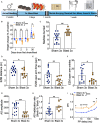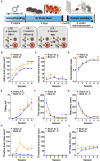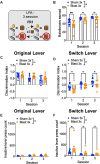Repetitive Blast Exposure Increases Appetitive Motivation and Behavioral Inflexibility in Male Mice
- PMID: 35002648
- PMCID: PMC8727531
- DOI: 10.3389/fnbeh.2021.792648
Repetitive Blast Exposure Increases Appetitive Motivation and Behavioral Inflexibility in Male Mice
Abstract
Blast exposure (via detonation of high explosives) represents a major potential trauma source for Servicemembers and Veterans, often resulting in mild traumatic brain injury (mTBI). Executive dysfunction (e.g., alterations in memory, deficits in mental flexibility, difficulty with adaptability) is commonly reported by Veterans with a history of blast-related mTBI, leading to impaired daily functioning and decreased quality of life, but underlying mechanisms are not fully understood and have not been well studied in animal models of blast. To investigate potential underlying behavioral mechanisms contributing to deficits in executive functioning post-blast mTBI, here we examined how a history of repetitive blast exposure in male mice affects anxiety/compulsivity-like outcomes and appetitive goal-directed behavior using an established mouse model of blast mTBI. We hypothesized that repetitive blast exposure in male mice would result in anxiety/compulsivity-like outcomes and corresponding performance deficits in operant-based reward learning and behavioral flexibility paradigms. Instead, results demonstrate an increase in reward-seeking and goal-directed behavior and a congruent decrease in behavioral flexibility. We also report chronic adverse behavioral changes related to anxiety, compulsivity, and hyperarousal. In combination, these data suggest that potential deficits in executive function following blast mTBI are at least in part related to enhanced compulsivity/hyperreactivity and behavioral inflexibility and not simply due to a lack of motivation or inability to acquire task parameters, with important implications for subsequent diagnosis and treatment management.
Keywords: behavioral flexibility; blast; executive function; motivation; traumatic brain injury; veteran.
Copyright © 2021 Baskin, Lee, Skillen, Wong, Rau, Hendrickson, Pagulayan, Raskind, Peskind, Phillips, Cook and Schindler.
Conflict of interest statement
The authors declare that the research was conducted in the absence of any commercial or financial relationships that could be construed as a potential conflict of interest.
Figures




Similar articles
-
Timing matters: Sex differences in inflammatory and behavioral outcomes following repetitive blast mild traumatic brain injury.Brain Behav Immun. 2023 May;110:222-236. doi: 10.1016/j.bbi.2023.03.003. Epub 2023 Mar 10. Brain Behav Immun. 2023. PMID: 36907289 Free PMC article.
-
Repetitive blast mild traumatic brain injury increases ethanol sensitivity in male mice and risky drinking behavior in male combat veterans.Alcohol Clin Exp Res. 2021 May;45(5):1051-1064. doi: 10.1111/acer.14605. Epub 2021 Apr 9. Alcohol Clin Exp Res. 2021. PMID: 33760264 Free PMC article.
-
Independent and Synergistic Associations Between TBI Characteristics and PTSD Symptom Clusters on Cognitive Performance and Postconcussive Symptoms in Iraq and Afghanistan Veterans.J Neuropsychiatry Clin Neurosci. 2021 Spring;33(2):98-108. doi: 10.1176/appi.neuropsych.20050128. Epub 2021 Jan 14. J Neuropsychiatry Clin Neurosci. 2021. PMID: 33441014
-
Different Neural Mechanisms Underlie Deficits in Mental Flexibility in Post-Traumatic Stress Disorder Compared to Mild Traumatic Brain Injury.Front Psychiatry. 2015 Dec 3;6:170. doi: 10.3389/fpsyt.2015.00170. eCollection 2015. Front Psychiatry. 2015. PMID: 26696907 Free PMC article. Review.
-
Examining the relationship between blast-induced mild traumatic brain injury and posttraumatic stress-related traits.J Neurosci Res. 2015 Dec;93(12):1769-77. doi: 10.1002/jnr.23641. Epub 2015 Sep 8. J Neurosci Res. 2015. PMID: 26346303 Review.
Cited by
-
Timing matters: Sex differences in inflammatory and behavioral outcomes following repetitive blast mild traumatic brain injury.Brain Behav Immun. 2023 May;110:222-236. doi: 10.1016/j.bbi.2023.03.003. Epub 2023 Mar 10. Brain Behav Immun. 2023. PMID: 36907289 Free PMC article.
-
Anxiety and risk-taking behavior maps onto opioid and alcohol polysubstance consumption patterns in male and female mice.bioRxiv [Preprint]. 2024 Aug 23:2024.08.22.609245. doi: 10.1101/2024.08.22.609245. bioRxiv. 2024. PMID: 39229006 Free PMC article. Preprint.
-
Enhanced attention in rats following blast-induced traumatic brain injury.Heliyon. 2024 Feb 10;10(4):e25661. doi: 10.1016/j.heliyon.2024.e25661. eCollection 2024 Feb 29. Heliyon. 2024. PMID: 38384534 Free PMC article.
-
The dynorphin/kappa opioid receptor mediates adverse immunological and behavioral outcomes induced by repetitive blast trauma.J Neuroinflammation. 2022 Dec 3;19(1):288. doi: 10.1186/s12974-022-02643-3. J Neuroinflammation. 2022. PMID: 36463243 Free PMC article.
References
-
- Amick M. M., Clark A., Fortier C. B., Esterman M., Rasmusson A. M., Kenna A., et al. . (2013). PTSD modifies performance on a task of affective executive control among deployed OEF/OIF veterans with mild traumatic brain injury. J. Int. Neuropsychol. Soc. 19, 792–801. 10.1017/S1355617713000544 - DOI - PMC - PubMed
-
- Elder G. A., Dorr N. P., De Gasperi R., Gama Sosa M. A., Shaughness M. C., Maudlin-Jeronimo E., et al. . (2012). Blast exposure induces post-traumatic stress disorder-related traits in a rat model of mild traumatic brain injury. J. Neurotrauma 29, 2564–2575. 10.1089/neu.2012.2510 - DOI - PMC - PubMed
Grants and funding
LinkOut - more resources
Full Text Sources
Research Materials

